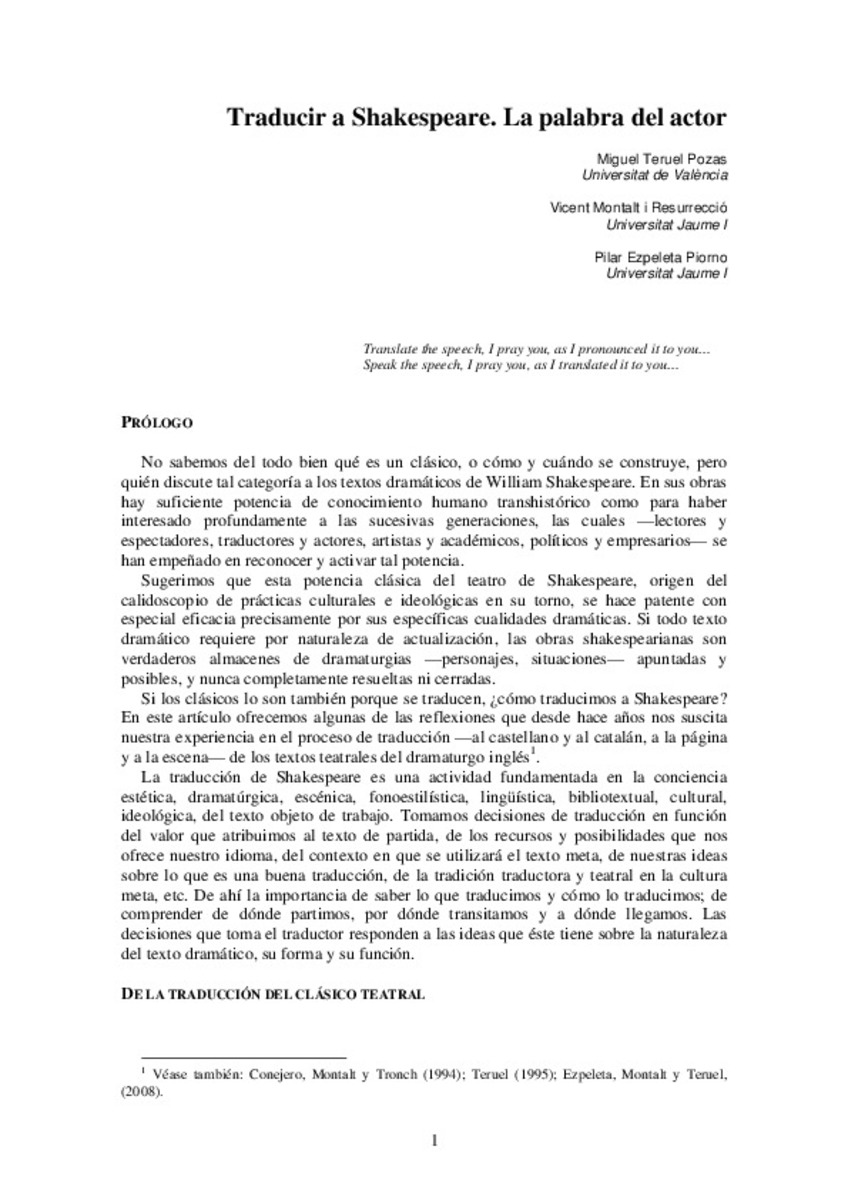Mostrar el registro sencillo del ítem
Traducir a Shakespeare : la palabra del actor
| dc.contributor.author | Teruel Pozas, Miguel | |
| dc.contributor.author | Montalt, Vicent | |
| dc.contributor.author | Ezpeleta-Piorno, Pilar | |
| dc.date.accessioned | 2011-06-22T08:32:02Z | |
| dc.date.available | 2011-06-22T08:32:02Z | |
| dc.date.issued | 2009 | |
| dc.identifier.issn | 1137-2311 | |
| dc.identifier.uri | http://hdl.handle.net/10234/24223 | |
| dc.description.abstract | En este artículo ofrecemos algunas de las reflexiones que desde hace años nos suscita nuestra experiencia en el proceso de traducción —al castellano y al catalán, a la página y a la escena— de los textos teatrales del dramaturgo inglés. La traducción de Shakespeare es una actividad fundamentada en la conciencia estética, dramatúrgica, escénica, fonoestilística, lingüística, bibliotextual, cultural, ideológica, del texto objeto de trabajo. Tomamos decisiones de traducción en función del valor que atribuimos al texto de partida, de los recursos y posibilidades que nos ofrece nuestro idioma, del contexto en que se utilizará el texto meta, de nuestras ideas sobre lo que es una buena traducción, de la tradición traductora y teatral en la cultura meta, etc. De ahí la importancia de saber lo que traducimos y cómo lo traducimos; de comprender de dónde partimos, por dónde transitamos y a dónde llegamos. Las decisiones que toma el traductor responden a las ideas que éste tiene sobre la naturaleza del texto dramático, su forma y su función | |
| dc.description.abstract | In this article we offer some of the reflections that our experience in the translation process —into Spanish and into Catalan, for the page and for the scene— of the dramatic texts written by the English playwright has risen for many years. Translating Shakespeare is an activity based on aesthetic, dramaturgy, scenic, phonostylistic, linguistic, bibliotextual, cultural and ideological awareness of the text which is subject of study. We take translation decisions following the value we attribute to the source text, the resources and possibilities offered by our language, the context in which the target text will be used, our ideas about what is a good translation, translational and theatrical tradition in the target culture, and so on. Hence the importance of knowing what and how we translate, of understanding the path we are following, and where are we coming to. Decisions taken by the translator respond to the ideas that he or she has on the nature of the dramatic text, its form and its function | |
| dc.format.extent | 15 p. | |
| dc.language.iso | spa | |
| dc.publisher | Universidad de Màlaga. Área de Lingüística Aplicada a la Traducción e Interpretación | |
| dc.relation.isFormatOf | Versió pre-print del document publicat a: http://www.trans.uma.es | |
| dc.relation.isPartOf | Trans: revista de traductología, no. 13 | |
| dc.rights | © Universidad de Màlaga. Área de Lingüística Aplicada a la Traducción e Interpretación | |
| dc.rights.uri | http://rightsstatements.org/vocab/InC/1.0/ | * |
| dc.subject | Shakespeare | |
| dc.subject | Castellano | |
| dc.subject | Catalán | |
| dc.subject | Traductor | |
| dc.subject | Traducción | |
| dc.subject | Texto dramático | |
| dc.subject | Spanish | |
| dc.subject | Translator | |
| dc.subject | Translation | |
| dc.subject | Dramatic texts | |
| dc.subject.lcsh | Shakespeare, William, 1564-1616--Translations into Spanish | |
| dc.subject.lcsh | Shakespeare, William, 1564-1616--Translations into Catalan | |
| dc.subject.other | Shakespeare, William, 1564-1616--Traduccions al castellà | |
| dc.subject.other | Shakespeare, William, 1564-1616--Traduccions al català | |
| dc.title | Traducir a Shakespeare : la palabra del actor | |
| dc.type | info:eu-repo/semantics/article | |
| dc.rights.accessRights | info:eu-repo/semantics/openAccess |
Ficheros en el ítem
Este ítem aparece en la(s) siguiente(s) colección(ones)
-
TRAD_Articles [342]
Articles de publicacions periòdiques







